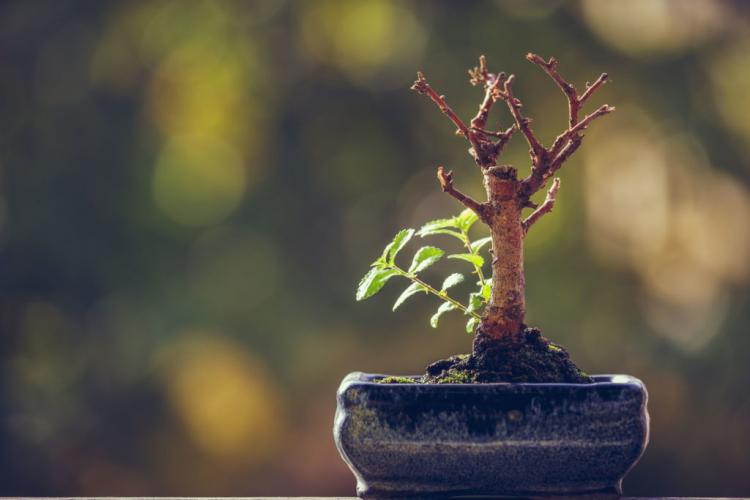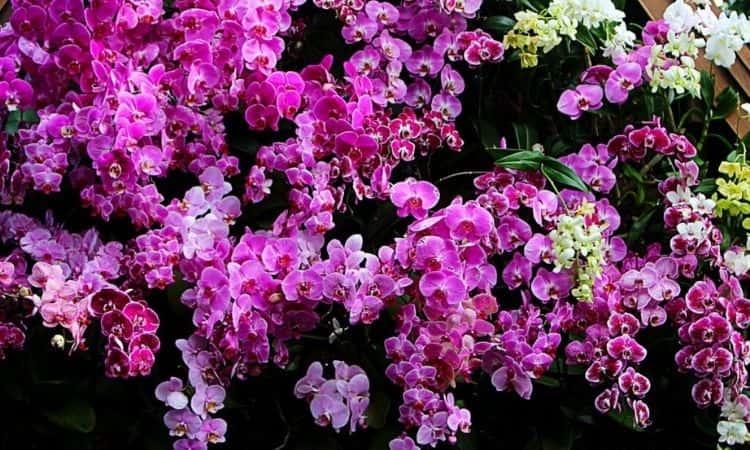Bonsai Leaving Leaves: What Can You Do About It?
The leaves of your beloved mini-sapling suddenly fall off? We explain what the causes for this can be and give tips on how to counteract them.
It has just been proudly carried home, replanted, or placed in its new, much nicer place in the sunny living room – but suddenly the bonsai is completely bare and bare. Despite the horror, it is now time to research: Why do the bonsai lose its leaves? The following list shows you numerous reasons that bonsais can cause leaves to shed. If you have an acute emergency to take care of, look directly at the bottom to see whether a bonsai without leaves can still be saved at all.
Bonsai is losing leaves: possible causes and reasons
Table of Contents
When a bonsai tree loses all of its leaves, the most common cause is a mistake in care. A lack or excess of water, a lack of light, a mistake in fertilization, or the wrong temperature can be the cause of a bonsai in the house or the garden dropping all the leaves. But even a sudden change of location or pests can cause sensitive bonsai trees to drop their covers.
Tip: excess water, lack of water, over-fertilization, and lack of nutrients. These issues can cause foliage to shed and they all affect the substrate of the bonsai. They can appear particularly quickly if unsuitable soil is used for the bonsai. Therefore, choosing suitable bonsai soil is an important first step in keeping a bonsai healthy.
Excess water
Too much water is not good for the bonsai at all. If a bonsai is always wet, no more oxygen can reach the roots and the entire substrate. The result is fermentation processes and the promotion of putrefaction. A substrate that is too absorbent can also be a problem. If the tree grows in material that is too absorbent, it never dries off properly and promotes harmful fungi and bacteria. Both of these slowly weaken the plant so that it can gradually shed all of its leaves.
The solution: Make sure you are using a suitable, permeable bonsai substrate for your bonsai and repot newly purchased bonsai as soon as you receive it – the container fillings from the sale are often a bit older or even specially adapted to the long transport and for permanent culture unsuitable. Always check the moisture of the substrate with your finger first and only pour when it is dry.
You might so like: 22 The Most Popular Bonsai Species
Lack of water
A lack of water can also lead to the shedding of leaves on bonsai. Because the plant pots of bonsai are relatively small to slow down the growth of the plant, the water-storing volume is also very limited. If watering is then neglected, no water is available at all – then the fall of leaves and the bonsai can very quickly be the result.
The solution: A lack of water can also be triggered by the above-mentioned “transport substrates”, because after drying they sometimes become hard as stone and can hardly be moistened again. So again the note: if possible, repot newly purchased bonsai immediately. Otherwise, it is simply a matter of watering regularly and using a high-quality bonsai substrate that retains sufficient water. If watering is difficult due to the tiny surface area, a weekly immersion bath of the entire pot can be a more practical alternative.

Lack of light
The small bonsai need a lot of sunlight. Indoor bonsai in particular often suffer from the fact that they are simply too dark. This leads to poor growth or, in the worst case, to the shedding of the leaves.
The solution: The right place for a bonsai is the light-flooded window on the south side. It is even better to put indoor bonsai outdoors in summer, where they can recharge their batteries in the form of sunlight. Just like for outdoor bonsai growing outdoors all year round, the perfect place for the bonsai in the garden is not in the blazing midday sun, but rather in the sloping morning or afternoon sun. However, it is advisable to get used to the new circumstances slowly to avoid sunburn and sudden lack of water as a result of the increased evaporation.
Tip: Ficus bonsais such as Ficus ginseng ( Ficus microcarpa ) and several Ulmus bonsais have a special characteristic: They quickly adapt the number of leaves to the respective light conditions. Because of this, it can happen that when the lighting conditions change, they suddenly shed some of their leaves and only keep the amount they really need – this is not necessarily a cause for concern.

Cold or heat stress
Not every bonsai is the same and every species has been adapted to specific conditions in its evolutionary history. If your bonsai is too cold or too warm, this can exceed its physiological possibilities, which can be shown in slowed growth, leaf shedding, and at some point in the death of the tree.
The solution: If the cold or heat stress is the cause of the leaf shedding, the solution is very simple: adapt the growth conditions of your protégé to their needs. It is even easier to explore the options available to you from the start and then choose the right bonsai.
Over-fertilization or lack of nutrients
A lack or excess of nutrients can also lead to leaf fall. While nutrient deficiency gradually becomes apparent through typical signs – the bonsai gets yellow leaves, hardly grows anymore, or shows typically arranged leaf discoloration – a nutrient excess is somewhat more difficult to recognize. In general, the plant then suddenly makes a limp impression, the foliage is therefore without internal cell pressure, soon changes color, and is quickly thrown off – if the plant is overfertilized, the death of the plant is as good as sealed. In contrast, the plant can withstand a lack of nutrients for a long period of time before shedding its leaves as a result.
The solution: A lot is gained when using fertilizers if you follow the manufacturer’s specifications. If you do not want to use a special bonsai fertilizer, you can determine the correct dosage by trying it out or asking the manufacturer specifically. In general, it is advisable to start with a little less fertilizer and to approach the optimal amount by observing the resulting growth behavior. After acute overfertilization, the root ball should be rinsed under plenty of running water as soon as possible – this will wash away excess nutrients and limit the damage. Organic fertilizers are primarily recommended for those who want to safely prevent over-fertilization is not possible with them.

Tip: Good bonsai soils contain a substantial proportion of fine clay minerals. These can absorb nutrients from the soil and store them but also release them again when required. In this way, surpluses are buffered and deficiencies are compensated.
Change of location
If a bonsai is suddenly moved and finds completely different conditions – drier air, less light, warmth, or cold – it takes a lot of strength to adapt to them again. Specialized cells are now formed in the plant or adapted transport routes for hormones or nutrients are converted – a huge, exhausting effort begins. So it’s no wonder that sensitive bonsai species tend to throw off all of their leaves. However, if you take good care of it, it usually grows back again soon. It is also not uncommon for a bonsai to lose all of its leaves after repotting. The shortening of the roots associated with this is a huge challenge for the small trees.
The solution: Unfortunately, falling leaves as a result of a change of location cannot be prevented. In no case should you move the plant straight away if you are frightened – it takes some time and, with good care, will soon sprout with new leaves. Remember, however, that good care does not necessarily mean frequent watering and fertilizing – without foliage, the plant has little need for it.
Tip: The beautiful June snow (tree of a thousand stars, Serissa japonica ) is particularly notorious for its sudden fall of leaves, which is why it is sometimes decried as a very demanding bonsai species. In fact, the June snow is pretty easy to care for, just the sudden fall of leaves after a change of location – for example from the shop to your living room – it owes its bad reputation.
Pests and diseases
Pests or diseases are very rarely the cause when a bonsai loses its foliage. Both often only appear when the bonsai has already been weakened by inanimate (abiotic) factors such as those mentioned above. And it is not uncommon for unnecessary treatment with pesticides to provoke leaf fall in the sometimes sensitive plants.
The solution: Bonsais are grown from a large number of very different tree species. And just as unmanageable is the abundance of pests and diseases that can lead to leaf fall on the various bonsai trees. If you have discovered a pest or disease, you should proceed as with any other plant: with determining the cause and subsequent targeted control.
Tip: Pests can also linger in the soil in the bonsai bowl. For example, fungus gnats are a common problem around the home. Their larvae are often introduced through poor-quality potting soil. Therefore, the following also applies here: Choosing high-quality bonsai soil can save you trouble later.
Bonsai loses all leaves in winter
Does your bonsai lose all of its leaves every year in winter? If the leaves fall, it doesn’t necessarily have to be a sign of a problem. All deciduous tree species from the temperate zone and even some conifers such as the larch ( Larix ) and the sequoia ( Metasequoia ) also lose their conifers in autumn.
The solution: Find out exactly what kind of bonsai your specimen is and check whether the leaf fall is not perhaps normal.

Can you save a bonsai without leaves?
If a bonsai has shed its leaves due to seriously unfavorable living conditions, this is a sign that it is already doing extremely badly. But if the plant is still alive, there is still some hope. If you’re not sure about this, there is a quick way to find out: scratch the bark flat with a sharp object or your fingernail to remove the top layers. If the green cambium can be seen underneath, this drive is still vital. It may well be that finer branches have already died, but the trunk is still alive and could sprout again. Therefore, if necessary, check different places on the bonsai.
What can you do now to help your bonsai survive in the best possible way? Repotting or cutting are initially taboo. Try to optimize the sapling’s living conditions, and most importantly, fix the problem that drove it to shed leaves. Depending on how many reserve substances the plant has stored in its roots and trunk, it will be able to muster the strength to shoot. If the bonsai was doing badly for years before the leaves were shed, the chances of a new beginning are not particularly good because there are hardly any reserves available. In general, a bonsai should have sprouted again by next spring at the latest – otherwise, its demise is unfortunately sealed.
If you would like to read more about the correct care of your bonsai, you will find our special article on watering bonsai trees here.







